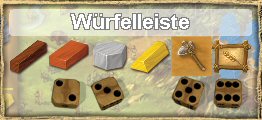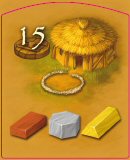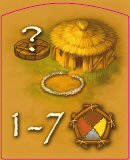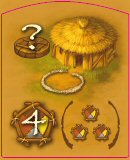StoneAge Zivilisations- und Gebäudekarten
Civilization cards
Each civilisation card is divided into two parts: the upper part of the card shows the bonus the player gets (most of the time immediately).
Upper part

Victory points (3x): The player immediately gets 3 victory points.

Raw material bonus (5x): The player immediately gets the raw material shown on the card.

Dice for raw material bonus (3x): The player casts two dice and gets the according number of raw materials as he would on the raw material area. Unused tools may be added to increase the total.

Food bonus (7x): the player immediately gets the number of food units shown on the card.

Card bonus (1x): The player immediately gets one face-down civilisation card from the stack. The upper part of the card is not used, only the bottom part counts for the final scoring

Increasing food supply (2x): The player immediately increases the number on his food supply counter by one.

One-time tool bonus (3x): The player gets one addional tool he can use once during the game. This tool is shown below the other tools of the player and offered for use automatically.

Permanent tool bonus (1x): The player gets an additional tool that he can use in the same way as the tools from the toolmaker for the rest of the game

Two raw materials (1x): The player gets any two raw materials. This card can be used immediately or kept for later use. It is stored directly below the food counter and can be used later by clicking on it and select the desired raw materials.

Dice bar (10x): All players benefit from this card. As many dice as there are players in the game are cast and then assigned to their number: 1 -> wood, 2 -> clay, 3 -> stone, 4 -> gold, 5 -> tool, 6 -> food.

The active player may choose his bonus first by steal it. Then the other players take turns to choose a bonus.
There are two different colours for the bottom part of the civilisation cards
Green civilisation cards








There are two cards of each symbol (weaving, pottery, medicine, transport, music, astronomy, writing and art)
Brown civilisation cards
There are four categories:




There are seven farmers distributed on 5 cards (7/5), toolmakers (8/5), hut builders (9/5) and shamans (7/5)
Building cards
There are three different types of buildings:

For this type of building the player must pay exactly the raw materials shown on the card and gets the points in the upper left corner. For this card the player has to pay one clay brick, one stone and one gold and he scores 15 points.

This type of building can be paid with any number of raw materials of the players choice. The player selects 1-7 raw materials and scores the total sum of their values. If for example the player decides to pay two wood, two stone and one gold, he gets 2x3 + 2x5 + 1x6 =22 victory points.

For this type of building, the number of raw materials the player has to pay is fixed. The total number is shown on the left, the number of differential raw materials he has to use is shown in brackets on the right. In this example the player has to pay raw materials in any combination of exactly three different materials, for example two wood, one clay brick and one stone.

